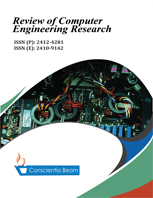Stanford University Interim Propagation Loss Model for a Gmelina Arborea Tree-Lined Road
DOI:
https://doi.org/10.18488/journal.76.2018.52.57.63Abstract
In this paper, the extended Stanford University Interim (ESUI) path loss model was evaluated and optimized based on empirically measured path loss obtained along a suburban road lined with Gmelina Arborea trees. The study was for a 1800 MHz cellular network located in Orlu Imo state. The field measurement was conducted in August which is in the rainy season with the entire trees blossom with their green leaves. G-NetTrack Lite 8.0 Adroid app installed on a Samsung Galaxy S8 mobile phone was then used to capture and log the received signal strength (RSSI) in dB, the geo-coordinates of the measurement points as well as the particulars of the 3G network base station. Two datasets were captured and one f the dataset was used for the model optimization while the other dataset was used for validation of the model. For the training dataset, un-tuned ESUI model had a root mean square error (RMSE) of 46.82 dB and maximum absolute prediction error of 46.64 dB whereas the RMSE-tuned ESUI model had a RMSE of 4.094dB and maximum absolute prediction error of 3.41dB. Similarly, for the validation dataset, the un-tuned ESUI model had a RMSE of 48.37dB and maximum absolute prediction error of 48.19 dB whereas the RMSE-tuned ESUI model had a RMSE of 4.39 dB and maximum absolute prediction error of 3.0 dB. In all, the tuned ESUI model was derived and it gave good path loss prediction performance for both the training and the validation datasets.





